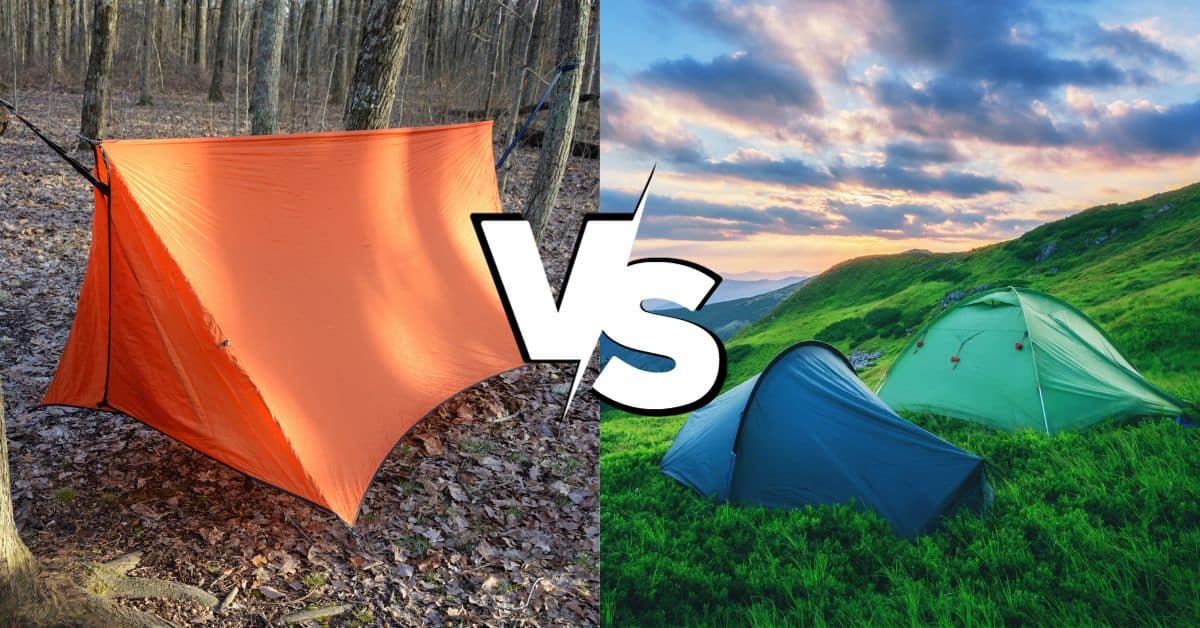So you’re planning your next wild camping adventure, and as you scroll through your gear checklist, you’re faced with a choice that’s sparked many a campfire debate among outdoor enthusiasts. Should you opt for the traditional tent or go minimalist with a tarp? Both offer a way to shelter in nature, but they provide different camping experiences that come with their own sets of pros and cons.
This decision isn’t just a matter of personal preference. It can also hinge on a variety of factors—from the weather conditions you expect to face to the type of camping experience you’re after.
Whether you’re a seasoned adventurer or someone new to the great outdoors, this article aims to shed light on the age-old tarp vs tent debate. We’ll delve into the nuances of each shelter type, compare their features, and help you make an informed decision for your next camping trip.
By the end of this comprehensive guide, you’ll be well-equipped to choose the best shelter for your needs, ensuring that your outdoor adventures are both safe and enjoyable.
Tarp vs Tents: The Pros and Cons at a Glance
Before we dive into the nitty-gritty details, let’s quickly look at the pros and cons of choosing a tarp or a tent for your outdoor adventures. Tents are your go-to for better protection against weather and insects. They offer ease of use, especially for beginners, and often come loaded with extra features like storage pockets and vestibules. The downside? They can be heavier and take up more pack space.
On the flip side, tarps offer significant weight savings and can be very versatile. Experienced campers may relish the open-air experience and the creativity tarps allow in setup configurations. However, tarps generally have a steeper learning curve and offer less protection against the elements and bugs.
Disclaimer: If you make a purchase via the links on our site, I may earn an affiliate commission at no additional cost to you. You can read my affiliate disclosure in the privacy policy. Thanks for your support!
Tent Basics
Let’s start by defining what a tent is. A tent is a portable shelter typically made of canvas, nylon, or other weather-resistant fabrics. Structurally, it usually comprises a set of poles that form its frame, anchored to the ground with stakes.
The tent footprint—that’s the ground area covered by your tent—varies in size, offering different options depending on your camping needs.
When it comes to sleeping arrangements, tents are versatile, offering compatibility with a variety of sleeping bags, inflatable mattresses, or even camping cots.

Pros of Tent Camping
When it comes to the benefits, tents offer quite a few:
- Better Protection: Tents come with a range of features designed to protect you from the elements. Their enclosed structure, combined with a weather-resistant fabric like polyester or nylon, provides a sturdy barrier against wind and rain.
- Ease of Use: Modern tents have simplified the setup process with features like colour-coded poles and quick-clip attachments. Plus, once you set it up, you don’t have to fiddle with it much during your stay.
- Weather-resistant Fabrics: Most quality tents are designed with a high hydrostatic rating, meaning they can withstand a good amount of rainfall without letting water seep through.
Cons of Tent Camping
However, tents are not without their shortcomings:
- Extra Weight: Tents, with their poles and stakes, can add extra weight to your backpack, which may not be ideal for long hikes.
- Less Connection with Nature: Being enclosed means you’re cut off from your natural environment to some extent. If stargazing or waking up to a sunrise is your thing, a tent might limit that experience.
- Setup Time: While many tents are easy to set up, they can still take longer than other shelter options, especially if you’re not familiar with the particular model.
Ideal Scenarios for Tents

Tents shine in particular situations:
Bad Weather: In conditions like heavy rain or strong winds, a tent is often your best option for staying dry and warm.
First-time Campers: If you’re new to the great outdoors, a tent provides a straightforward, relatively foolproof way to ensure you have a safe place to sleep.
Car Camping: When you don’t have to worry about carrying your shelter long distances, the extra weight and setup time of a tent are less of an issue.
Tarp Basics
A tarp, short for tarpaulin, is a large sheet of strong, flexible, and often waterproof material. When it comes to camping, tarps are usually made of lightweight materials like nylon or polyester.
Unlike tents, tarps don’t come with a predefined shape or structure. Instead, you use guy lines, stakes, and sometimes even nearby trees or hiking poles to create a tarp shelter.
Additionally, tarps can be paired with a bivy sack—a small, lightweight, waterproof shelter—to offer an enclosed space for sleeping.

Pros of Tarp Camping
Tarps offer their own set of unique advantages:
- Lighter Material: If cutting down on weight is your priority, tarps are usually the lighter option, especially when compared to standard tents.
- Open Air Experience: Sleeping under a tarp allows for a more immersive outdoor experience. You’re less isolated from your surroundings, which many find appealing.
- Versatility: The open design of a tarp lets you set it up in different ways depending on your needs and the terrain, offering a more personalized camping experience.
- Compatibility with Other Gear: Tarps work excellently with bivvy bags and hammocks, allowing for a variety of shelter options to suit your camping style and the natural environment you find yourself in.
Cons of Tarp Camping
Of course, tarps have their limitations as well:
- Learning Curve: Setting up a tarp shelter that provides sufficient protection and comfort can be challenging, especially for first-timers.
- Exposure to Bugs: Without the enclosed space that tents provide, you’re more susceptible to bugs. While a bug net can help, it’s an additional piece of gear to carry.
- Rough Terrain: Tarps are less forgiving than tents when it comes to uneven or rocky ground, as they don’t offer a bathtub floor or other protections against the elements beneath you.
Ideal Scenarios for Tarps

Tarps are best suited for specific circumstances:
Good Conditions: If the weather forecast is favorable, and bugs aren’t a significant concern, a tarp can be a great option.
Casual Camper: If you’re not planning a rugged, long-term expedition, a tarp can provide a simple and enjoyable shelter.
Survival Uses: Tarps are often included in survival kits due to their lightweight and versatile nature, making them a suitable option for emergency situations.
Tents vs Tarps – The Ultimate Showdown

Weather Conditions
Tents: These are generally better suited for adverse weather conditions. Most modern tents are designed with a double-wall construction and come with a separate rain fly, making them well-equipped to handle both wind and rain.
Tarps: While some seasoned outdoor enthusiasts can rig a tarp to offer decent protection from the elements, it’s generally less reliable in bad weather. A waterproof tarp can fend off light rain, but it’s not the best shelter for stormy conditions.
Ease of Use
Tents: Modern designs and features make tents relatively simple to set up, especially for those familiar with camping. They are often a great choice for casual campers or those new to the outdoor adventure scene.
Tarps: A tarp’s simplicity can be both an advantage and a drawback. While they’re lighter and more versatile, they come with a learning curve, especially when it comes to setting them up effectively.
Weight and Portability
Tents: Tents can add considerable weight to your backpack, particularly if they’re designed for multiple seasons or extreme weather. Ultralight tents are available but can be expensive.
Tarps: One of the lightest shelter options out there, a tarp is a great choice for those who are counting every ounce in their pack.
Versatility
Tents: While tents offer less versatility in terms of setup, many come with extra features like internal pockets and vestibules that provide added convenience and space.
Tarps: The versatility of a tarp is one of its standout features. It can be set up in various ways and adjusted to different conditions. Plus, a tarp can serve multiple functions, doubling as a rain cover for gear or a cooking area.
Cost
Tents: High-quality tents can be a significant investment but are generally durable and come with warranties.
Tarps: Generally more affordable than tents, tarps offer a cost-effective way to get into outdoor camping, especially if you’re on a budget.
Your choice between a tent and a tarp could ultimately come down to personal preference and the kind of camping experience you seek.
If you’re looking for a more traditional, protected environment, a tent might be your best bet. On the other hand, if you crave an open-air experience and have the skills to set up a tarp effectively, it could be the best option for you.
Advanced Considerations and Pro Tips

Hybrid Solutions: Tarp Tents and Bivy Sacks
Can’t decide between a tent and a tarp? Well, there are hybrid options like tarp tents and bivy sacks. Tarp tents combine the lightweight advantages of tarps with the structure and protection of a tent. Bivy sacks, on the other hand, offer a minimalist, one-person shelter that can be combined with a tarp for added protection.
Material Matters: Waterproof vs. Water-Resistant
When it comes to weather protection, the material is a big deal. Look for shelters made from waterproof material like silnylon or polyurethane-coated fabrics for better protection. Water-resistant fabrics can handle light rain but may not hold up in a downpour.
Attachment Points and Guy Lines
Whether it’s a tent or a tarp, the effectiveness of your shelter is often as good as its weakest point. Pay attention to attachment points and the quality of your guy lines. Durable, well-placed attachment points and strong guy lines can make a world of difference in the stability and durability of your shelter.
Floor or No Floor?
Another aspect to consider is whether you need a floor. Tents come with a built-in floor, often designed with a bathtub style to keep water out. Tarps usually don’t offer this feature, although some advanced setups allow for a makeshift floor using the same tarp or an additional groundsheet.
Extra Features and Accessories
From built-in bug nets to storage pockets, tents often come loaded with extras that can make your camping experience more convenient. Tarps are simpler by design but can be customized with accessories like bug nets or even a small camping stove for an open-air cooking experience.
Expert Tips
- Trial Runs: Before committing to either a tent or a tarp for an extended camping trip, try both on shorter excursions to gauge your comfort and proficiency with each.
- Ask other Campers: Use social media or camping forums to seek advice from experienced campers who have similar outdoor interests. You’d be surprised how much you can learn from others’ experiences.
- Invest in Quality: Whether you opt for a tent or a tarp, investing in a quality product is always a good idea. Durable, well-designed shelters will stand up to the rigours of the outdoors much better than cheaper alternatives.
Wrapping It Up – Making Your Choice
So, you’ve been through the ins and outs, the pros and cons, and even some advanced considerations. By now, you should have a better idea of what suits your specific needs and preferences. Whether you’re planning a casual camping weekend or a rugged backcountry adventure, your choice of shelter plays a pivotal role in your overall experience.

Quick Recap
Tents offer better protection against weather and bugs, ease of use, and often come with extra features like storage pockets or vestibules. However, they can be heavier and generally less versatile than tarps.
Tarps shine in versatility, weight savings, and providing an open-air experience. They’re great for seasoned campers who don’t mind a bit of a learning curve and are comfortable with a more minimalist setup.
Your next camping adventure could be the perfect opportunity to test out a new type of shelter. Take into account the weather conditions, the type of terrain you’ll encounter, and how comfortable you are with setting up each type of shelter.
Final Thoughts
Both tents and tarps have their place in the great outdoors. Your ultimate choice might come down to personal preference, and that’s completely okay. Whether you opt for the enclosed protection of a tent or the liberating experience of a tarp, the most important thing is to enjoy your time in the natural environment.
Interested in some top-notch gear recommendations and tips for wild camping? Check out our comprehensive guide for beginners here.
You may also like our guide on the best tents for wild camping here.
Tarp vs Tent FAQ
Can a tarp really replace a tent for camping?
A tarp can replace a tent in certain conditions, mainly in good weather and for campers who are comfortable with a more minimalist setup. However, a tent offers better protection against bad weather and insects, making it a more versatile option for various conditions.
What’s the learning curve like for setting up a tarp?
Setting up a tarp can be simple or complex depending on the configuration you choose. It generally requires more skill and experience compared to setting up a tent. Practice is key here, and it’s a good idea to try different setups during short trips before relying on a tarp for longer adventures.
Are there any hybrid options between a tarp and a tent?
Yes, tarp tents offer a middle ground between the two. These hybrids combine the lightweight nature of a tarp with some structural features of a tent, such as partial walls or even a floor, providing a good compromise between weight and protection.
How do I choose the best material for my tent or tarp?
For tents, look for materials with high hydrostatic ratings for better water resistance. Tarps made from silnylon or polyurethane-coated fabrics offer better waterproofing. The choice of material can also affect the weight, so consider your needs carefully.
Do I need a footprint or groundsheet?
A footprint or groundsheet is generally a good idea for both tents and tarps. For tents, it adds an extra layer of protection to the floor. For tarps, it can serve as a makeshift floor, protecting you from damp or rough terrain.
What about bugs? How do I keep them away if I’m using a tarp?
Tarps generally offer less protection against bugs compared to tents with built-in bug nets. If bugs are a concern, you can pair your tarp setup with a separate bug net or even consider using a bivy sack with built-in bug protection.

About the Author
Steve Cleverdon is an adventure blogger dedicated to helping outdoor enthusiasts make the most of their outdoor experiences. With years of travel and many epic adventures including a 3000-kilometre solo hike across New Zealand, Steve has amassed practical knowledge on outdoor gear. You can learn more about his adventures here. Through expert reviews, recommendations, and guides, he equips his readers with the best gear for their next adventure. If you want to send Steve a quick message, visit his contact page here.




